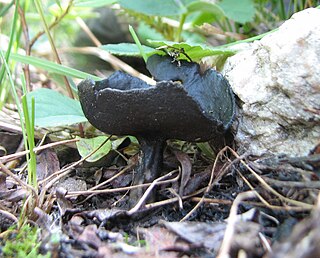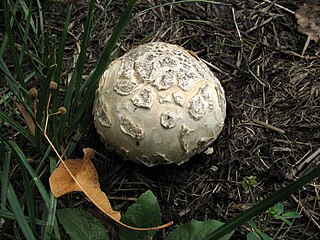Phanerochaete carnosa is a species of crust fungus in the family Phanerochaetaceae. It is a plant pathogen that infects plane trees. The fungus was first described to science by Edward Angus Burt in 1926 as a species of Peniophora. It was transferred to the genus Phanerochaete by Erast Parmasto in 1967.

Phanerochaete is a genus of crust fungi in the family Phanerochaetaceae.

The Phanerochaetaceae are a family of mostly crust fungi in the order Polyporales.

Erast Parmasto was a noted Estonian mycologist, bioscientist and botanist and onetime director of the Estonian Institute of Zoology and Botany.

Byssomerulius is a widely distributed genus of crust fungi.

Phlebia is a genus of mostly crust fungi in the family Meruliaceae. The genus has a widespread distribution. Phlebia species cause white rot.

Mycoacia is a genus of toothed crust fungi in the family Meruliaceae. It was circumscribed by Dutch mycologist Marinus Anton Donk in 1931.

Helvella corium is a species of fungus in the family Helvellaceae of the order Pezizales. This inedible cup-shaped fungus is black, and grows on the ground often near willows in deciduous or mixed forests.

Mycenastrum is a fungal genus in the family Agaricaceae. The genus is monotypic, containing one widely distributed species, Mycenastrum corium, known by various common names: the giant pasture puffball, leathery puffball, or tough puffball. The roughly spherical to turnip-shaped puffball-like fruit bodies grow to a diameter of 6–24 cm (2–9 in). Initially covered by a thick, felted, whitish layer, the puffballs develop a characteristic checkered skin (peridium) in age. When the internal spore mass, the gleba, is firm and white, the puffball is edible, although some individuals may suffer mild gastrointestinal symptoms after eating it. As the spores mature, the gleba turns first yellowish then purplish brown. Spores are released when the peridium eventually splits open into irregularly shaped sections. Microscopically, the gleba consists of spherical, dark brown spores with rounded bumps on their surfaces, and a capillitium—intricately branched fibers that form long thorn-like spines. The puffball grows on or in the ground in prairie or desert habitats. Although widely distributed, it is not commonly encountered. Mycenastrum corium is a threatened species in Europe.
Dictyonema is a genus of mainly tropical basidiolichens in the family Hygrophoraceae.
Bondarcevomyces is a genus of fungus in the Tapinellaceae family. It is a monotypic genus, containing the single species Bondarcevomyces taxi, found in Asia. The species was originally described as Polyporus taxi by Appolinaris Semyonovich Bondartsev in 1940, and was transferred to the genera Hapalopilus, Tyromyces, and Parmastomyces before being made the type of the newly created Bondarcevomyces, published in Mycotaxon Vol.70 on page 219 in 1999.

The corium is the thickened, leathery, basal portion of the forewing or hemelytron of an insect in the order Hemiptera, suborder Heteroptera. Specifically, the large anterior portion of the basal region is the corium.

Fibroporia is a genus of ten species of poroid crust fungi in the family Fomitopsidaceae. The genus contains species similar to those in genus Antrodia, but they are phylogenetically distinct.
Leucogyrophana pseudomollusca is a fungus of the genus Leucogyrophana and family Hygrophoropsidaceae. It was originally described by Estonian mycologist Erast Parmasto in 1962 as a species of Merulius. He transferred it to Leucogyrophana in 1967.

Crustoderma dryinum is a species of crust fungus in the family Meruliaceae, and the type species of the genus Crustoderma. It is found in Europe and Asia, where it causes a brown rot on conifer wood.
Auriporia pileata is a species of poroid fungus. Found in East Asia, it was described as a new species in 1980 by Czech mycologist Erast Parmasto.

The Irpicaceae are a family of mostly polypores and crust fungi in the order Polyporales.

Byssomerulius psittacinus is a species of crust fungus in the family Irpicaceae. It was described as new to science in 2000 by mycologists Peter Buchanan, Leif Ryvarden, and Masana Izawa. The type was found in Fiordland National Park, where it was growing on the dead wood of Nothofagus. The specific epithet psittacinus ("parrot-like") refers to the wide range of colours observed in the fruit bodies. Initially a striking reddish-purple when fresh, it dries to brownish orange, pale orange yellow, or pale orange.
Aleurodiscus lividocoeruleus is a species of fungus belonging to the family Stereaceae.
Acanthophysellum is a genus of fungus belonging to the family Stereaceae.












